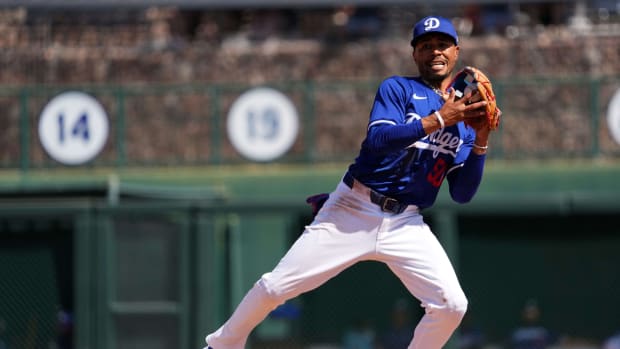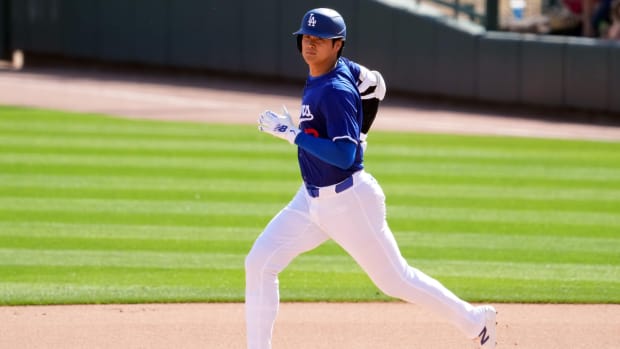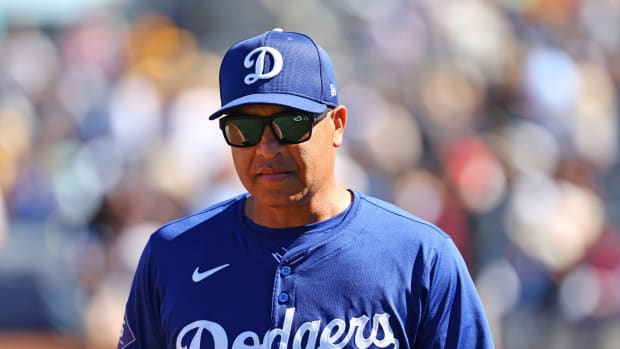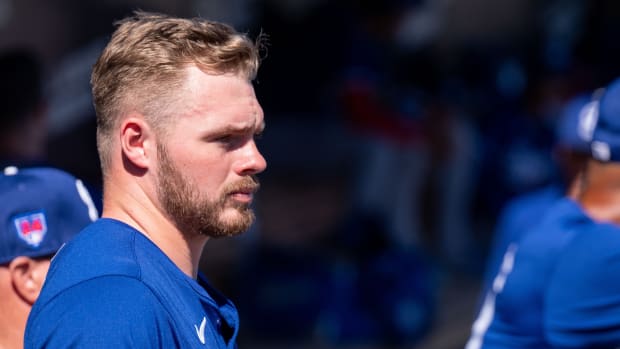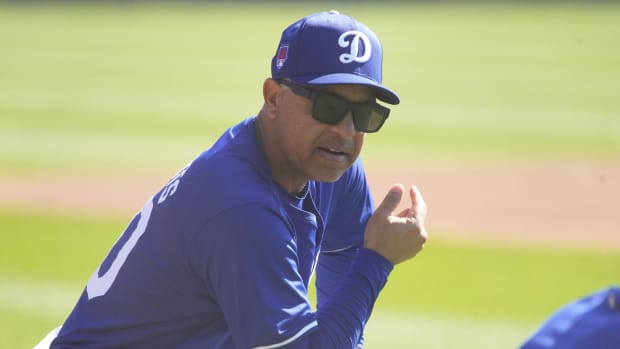Dodgers History: The Brief Reign of the Brooklyn Superbas
The final two decades of the nineteenth century, which were also the first two full decades of major league baseball, featured four dynastic teams. Cap Anson’s Chicago White Stockings, the forebears of today’s Cubs, won five pennants from 1880-86. The American Association’s St. Louis Browns, led by manager/first baseman Charlie won four straight pennants from 1885-88 and beat the NL’s White Stockings in the 1886 World Series. They would later join the National League and become the Cardinals. The Boston Beaneaters, now the Braves, book-ended the 1890s with five pennants under the guidance of manager Frank Selee and behind the workhorse pitching of Kid Nichols. In between, the NL’s Baltimore Orioles won three straight pennants and posted a winning percentage of .658 or better every year from 1894-98.
Of those four teams, the Orioles loom largest in the modern imagination for three reasons. The first is that, under manager Ned Hanlon, they pioneered a more team-oriented style of play, which would dominate the ensuing decades. Hanlon and the Orioles didn’t invent the hit-and-run, sacrifice bunting, or backing up other fielders, but they brought all of the above to a new level of prominence. They also bent and broke the rules at every opportunity afforded to them by the fact that the lone umpire then tasked with officiating National League games could only look at one thing at a time. They cut corners on the bases, obstructed runners, and hid extra balls in the outfield so their outfielders could get a throw back in with artificial quickness. They also employed a groundskeeper to alter the field to their advantage, including pouring concrete under the dirt in front of home plate to assist with the Baltimore chops that would ever-after bear their city’s name. As such shenanigans might suggest, the Old Orioles, as they would be known in the twentieth century, also shed whatever decorum remained from the game’s origins as a gentleman’s pastime. Demonstrative in celebration and complaint, they were not above verbally and physically abusing umpires, opponents, and, if necessary fans.
The second reason that the memory of the Orioles endures is that the team’s hyper-competitive approach to the game—with some, but not all, of the roughest edges sanded off—was carried forward into the twentieth century by a managerial tree that began with Hanlon and Baltimore’s irascible third baseman John McGraw and extended through, among others, Casey Stengel, Billy Martin, and Lou Piniella, the last of whom managed through the 2010 season. Current Reds skipper David Bell, who played for three-plus years under Piniella in Seattle and led the NL in ejections as a rookie manager in 2019, arguably brings that continuum up to the present day.
What elevates the Orioles from history to curiosity, however, is the fact that the franchise didn’t survive its greatest decade. The Orioles won 96 games in 1898, posted a .581 winning percentage in 1899, and then they were gone. Born in the American Association in 1882, the Orioles spent just eight seasons in the National League, were good or great in the last six of them, then ceased to be. Unlike the White Stockings, Browns, and Beaneaters, they left no descendant. The original American League Orioles, who moved to New York to become the Yankees in 1903, bore no official relation, and the modern Orioles are the relocated American League St. Louis Browns, which themselves came into existence as the Milwaukee Brewers in 1901. The current franchise is related to neither of the nineteenth century dynasties nor the modern expansion team whose names it has shared. The Old Orioles are thus not an official part of any modern team’s history.
[Follow Sports Illustrated’s Inside the Dodgers on Twitter.]
If any team could claim them, however, it would be the Dodgers. By the end of the 1898 season, the Dodgers were in financial straits coming off a span of three losing seasons during which two of their four owners, Joseph Doyle and Charles Byrne, died and a third, George Chauncey, sold his shares to Ferdinand Abell, the remaining principal, and rising team executive Charles Ebbets. The Orioles were still winning, but had lost the last two pennants to Boston. Both teams saw their attendance drop dramatically in 1898, the year of the Spanish-American War. The Orioles drew less than half as many fans that year as in 1897.
As there was no rule against owning stakes in multiple teams back then, the owners of the two clubs, Abell in Brooklyn and Harry Von der Horst in Baltimore, came upon a solution to their mutual misery: syndicate ownership. Abell and Von der Horst struck a deal that gave each approximately 40 percent ownership of each club, with Baltimore manager Hanlon and Brooklyn team president Ebbets splitting the remainder. To maximize their revenues, the syndicate then combined the assets of the two clubs to constitute a winner, led by Hanlon, in Brooklyn, the larger of the two markets.
In a single March 1899 transaction, the syndicate reassigned nine Orioles players to Brooklyn, including future Hall of Famers Willie Keeler, Hughie Jennings, and Joe Kelley, right-handers Jay Hughes and Doc McJames, who would combine for 47 wins that season, and first-baseman Dan McGann. The move also sent shortstop Bill Dahlen, a defensive whiz who deserves to be in the Hall of Fame, to Brooklyn less than two months after the Orioles had acquired him in a legitimate trade with Chicago. During the 1899 season, Brooklyn made a pair of trades with Washington to add catchers Duke Farrell and Deacon McGuire and third baseman Doc Casey. Four of the five players dealt in those two trades, McGann among them, had been Orioles prior to the merger.
Piling that talent on top of incumbent ace Brickyard Kennedy, workhorse Jack Dunn, second baseman Tom Daly, and centerfielder Fielder Jones, Brooklyn rocketed from a tenth-place finish in 1898 to a then-record 101 wins and the pennant in 1899, besting the resurgent Beaneaters by eight games. The local press dubbed the super-charged Brooklyn club the Superbas, taking the name from a contemporary acrobatics exhibition called “Superba” (think Cirque du Soleil) staged by the Hanlon Brothers, no relation to skipper Ned but the association certainly intended.
The Superbas lived up to their new name, but the writers could just as legitimately have called them the Orioles. Indeed, the Superbas looked more like the 1890s Orioles than anything we’d recognize as the Dodgers. At home, their uniforms were white with red accents. The only distinguishing mark between their blank white pillbox cap down and their red socks was a red Old English B on the left breast of their collared shirts. The Dodgers’ blue wouldn’t arrive until 1902, the Brooklyn B not until 1909.
Still, the syndicate had not transplanted the Orioles wholesale. McGraw and catcher Wilbert Robinson both refused to move to Brooklyn as they had a thriving sports bar in Baltimore called the Diamond Café, which generated a significant portion of their income. Ironically, both would be key figures in the Dodgers-Giants rivalry in the next century. Jennings, the Orioles’ best player during their heyday in part thanks to his superlative play at shortstop, effectively left his throwing arm in Baltimore, suffering an injury that forced a move to first base.
However, syndication set the stage for contraction. The Browns consumed the Cleveland Spiders after the 1898 season, becoming the Perfectos and leaving Cleveland to suffer through a still unmatched 20-134 season. The Pirates, who acquired their name from a contentious player transaction at the start of the decade, were in the process of pilfering Louisville Colonels. With the Superbas siphoning off the Orioles’ best players, the league opted to fold its Cleveland, Louisville, Washington, and Baltimore franchises after the 1899 season.
As a result, Brooklyn added more Baltimore talent for 1900, most notably Hall of Famer Joe McGinnity, righty Frank Kitson, young outfielder Jimmy Sheckard and swing-man Harry Howell, both of whom had been sent in the other direction the year before. Led by the submarining McGinnity, who topped the league with 28 wins and 343 innings pitched, taking on the nickname “Iron Man” both for having worked in an iron foundry the previous offseason and for winning five games in a six-day stretch mid-season, the Superbas repeated as NL champions in 1900, besting the Pirates by 4 1/2 games.
The reign of the Superbas ended almost as quickly as it started, and by similar means. Prior to the 1901 season, Ban Johnson’s Western League was reborn as the American League, a new major league to rival the NL, and declared war on the senior circuit, poaching players at an alarming rate. The Superbas lost McGinnity and Howell to the AL’s new Orioles, centerfielder Jones to the White Sox, and regular third baseman Lave Cross to the new Philadelphia Athletics. To make matters worse for Brooklyn, Johnson chose to leave the Pirates intact in an effort to unbalance the rival league and shift its center of power away from New York.
It worked. The Superbas were still good in 1901, benefitting from the maturation of Sheckard and righty Wild Bill Donovan, but they finished a distant third, 9 1/2 games behind the Pirates, who, led by former Louisville Colonel Honus Wagner, would win three straight NL pennants. After the 1901 season, Kelley jumped to the new Orioles, second baseman Daly jumped to the White Sox, and catcher McGuire jumped to the Tigers. In 1902, Brooklyn finished in second place, but a whopping 27 1/2 games behind Pittsburg (which went without an H from 1891 to 1911). That winter, Donovan and Kitson jumped to the Tigers, Keeler jumped to the relocated Orioles in New York, centerfielder Cozy Dolan jumped to the White Sox, and catcher Duke Farrell jumped to the AL’s Boston franchise. In 1903, Brooklyn sank to fifth place. The team wouldn’t finish higher until the middle of the next decade. The Old Orioles were all gone, and so were the Superbas.
Cliff Corcoran covers baseball for The Athletic and is a former lead baseball writer for SI.com. The co-author or editor of 13 baseball books, including seven Baseball Prospectus annuals, he has also written for USA Today, SB Nation, Baseball Prospectus, Sports on Earth, The Hardball Times, and Boston.com, among others. He has been a semi-regular guest analyst on the MLB Network and can be heard more regularly on The Infinite Inning podcast with Steven Goldman. Follow Cliff on Twitter @CliffCorcoran.

